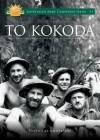To Kokoda
Written by: Nicholas Anderson
Australian Army Campaigns Series 14
Big Sky Publishing, 2014,
ISBN: 9781922132963186pp, 186pp,
Reviewed by: Wing Commander Mark Smith
The Kokoda campaign ranks second to the Gallipoli campaign in the national psyche and also probably in the number of Australian military history books devoted to a single campaign. With the approach of the 75th anniversary of the Kokoda campaign in 2017, there are likely to be more dissertations published and the myth versus reality debate of this particular campaign will continue.
To Kokoda is the fourteenth volume in the Australian Army Campaign Series and, judging from the Army Historian’s series introduction, well meets its criteria. The author, Nicholas Anderson, has drawn from the large number of previous publications, all listed in the bibliography, to create a succinct and very readable account of the campaign in 225 pages. The text is very well supported by maps of the individual battles, a range of photos — some quite well known and others less so — and both the Australian and Japanese order of battle. Of particular interest are the recent photographs of key terrain taken by members of the walk on the Kokoda track that the author completed in 2012. As with the other volumes of this series, the use of sidebars complements the text.
The author has paid particular attention to aspects of the difficulties of command down to sub-battalion level highlighting that the lack of effective and timely communications — caused by difficult terrain, poor radios and intermittent telephone lines — led to units positioned out of place and the consequent confusion when rapid repositioning was required. While most examples describe in sufficient detail the cause and effect of the poor communications, two examples stand out as lacking explanation
for the action undertaken by the units involved. These were the apparent self-initiated repositioning of a 53rd Battalion platoon, leaving an important track junction near Efogi unguarded (p. 89) and the failure of the 2/1st Pioneers to move forward along the track (p. 102).
While Anderson displays tenacity, there is a level of caution evident suggesting that the author is not quite ready to dismiss all the ‘myths and legends’ that have surrounded Kokoda. For example, the inclusion of legendary events such as Lieutenant Colonel Ralph Honner’s comments to Captain Merrit while shaving adds ‘colour’ to the book. Fortunately, the glaring myths of the past, particularly the mythical imbalance in opposing forces, are put to one side, supporting some of the recent and more factual studies of the campaign. The author leaves no doubt about his attitude towards the renditions of Kokoda presented by ‘popular’ media personalities (p. 212). Anderson raises some of the incompatibilities and differences between the Official History, various brigade and battalion diaries and other personal accounts and offers only limited explanations — most likely due to the limited space available in the book. This should not be interpreted as a negative as it may well point future historians to more detailed research. He is not afraid to question points and arguments raised by other historians, but may have been a little disingenuous towards Peter Williams, author of the 2012 publication The Kokoda Campaign 1942 — Myth and Reality, contending that Williams’ explanation that the cautious advance of the Japanese 2/144th Battalion on Alola was due to the 53rd Battalion’s fighting performance was implausible as Williams had mistaken the dates (p. 59).
This is Anderson’s first book and a very worthy addition to the Australian Army Campaign Series. To Kokoda is recommended to anyone with an interest in the campaign, particularly as a first book to introduce newcomers to this most gruelling operation.

